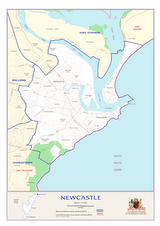An Inconvenient Truth
For those who have recently seen An Inconvenient Truth, Al Gore’s contribution to the climate change debate, you may remember when he says what is likely to happen if the ice shelf in Greenland melted or if part of the ice shelf in West Antarctica melted.
The complete melting of Greenland would raise sea levels by 7 metres (23 feet). But even a partial melting would cause a one-metre (three-foot) rise. Even a one-metre rise would devastate areas in the Lower Hunter, particularly Stockton and inner city suburbs and areas around Lake Macquarie.
A new study, based on data gathered by a pair of NASA satellites orbiting Earth shows that Greenland continued to lose ice mass at a significant rate through April 2006, and that the rate of loss is accelerating. The study appears in the 21 September 2006 issue of Nature magazine.
The study indicates that from April 2004 to April 2006, Greenland was shedding ice at about two and one-half times the rate of the previous two-year period, and had lost roughly 684 cubic kilometres of ice from April 2004 to April 2006 (roughly 1200 Sydney Harbour’s or 400 Lake Macquarie’s).
Some businesses are not burying their head in the sand and recognise that climate change poses serious threats to Australia’s economy and uncertainty about future climate policy heightens the risks associated with investment.
The Australian Business Roundtable on Climate Change (members are BP Australia, Insurance Australia Group, Origin Energy, Swiss Re, Visy Industries and Westpac) was formed to advance the understanding of business risks and opportunities associated with climate change and to help develop effective policy frameworks and market conditions for our low carbon future.
The Roundtable commissioned CSIRO to determine climate impacts on Australia, and the Allen Consulting Group to model the economic effects of producing a 60% reduction on year 2000 emissions by 2050, for its report The Business Case for Early Action. The Roundtable's report shows, for the first time, that it is possible for Australia to deliver significant reductions in greenhouse gas emissions at an affordable cost, whilst maintaining strong economic growth.
What can we do?
1. We need to all reduce our consumption
Switch to Green Power, turn appliances off at the wall (10% of Australian household electricity use goes on standby power), have short efficient showers, adjust the thermostat on the hot water heater (each degree equals about 10% of energy consumption) and leave the car at home (see Australian Conservation Foundation website).
2. Lobby the Government
The State Government must make an immediate start to the transition of the electricity industry to a renewable energy and energy efficiency basis. There must be significant investment in renewable energy and energy efficiency.
There must be a phasing out of all existing subsidies to coal mining, including immediately ending the Federal government’s diesel fuel rebate for mining operations.
There needs to be “just transitions” for communities that have traditionally derived income from coal mining operations, to support job creation and the development of a secure economic future for those communities. Funding for retraining and the seeding of new industries in coal communities should be paid for by a levy on existing coal mines.




